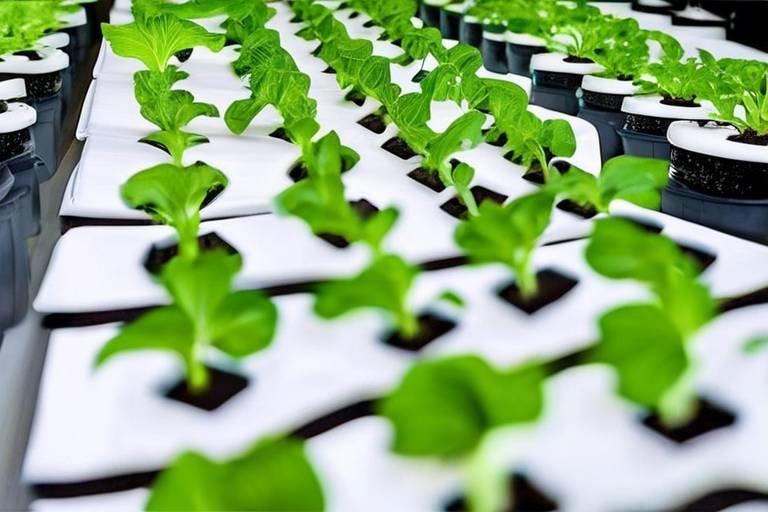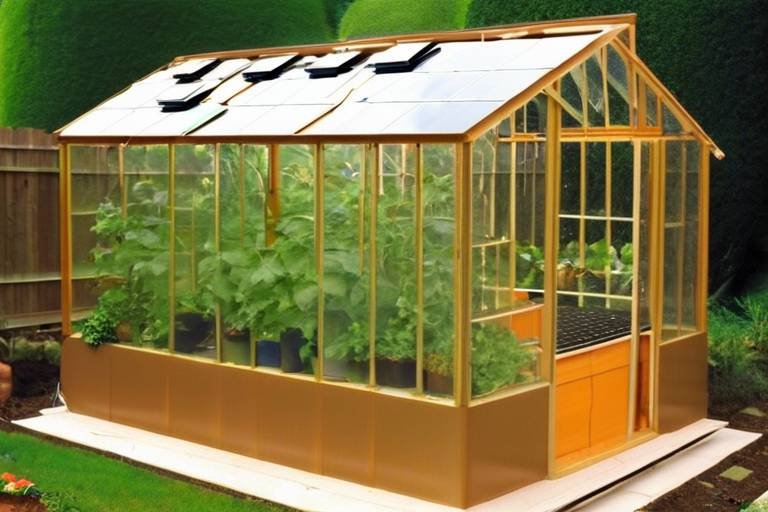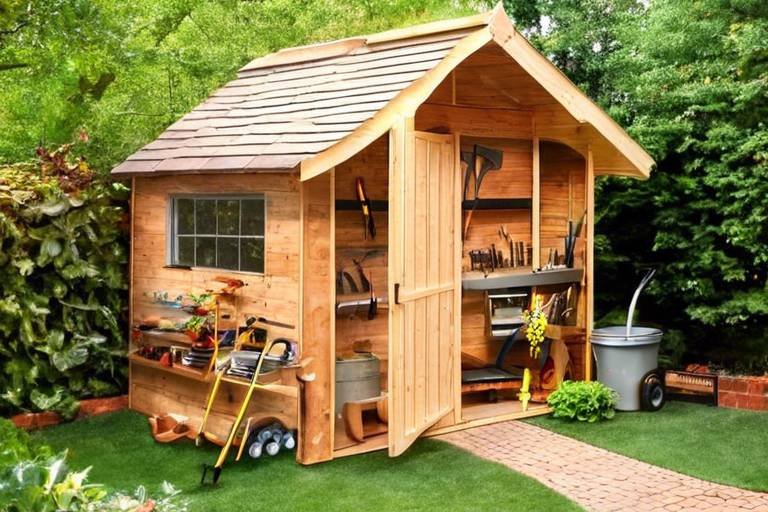How to Start a Hydroponic Garden
Hydroponic gardening is a fascinating method of cultivating plants without the use of soil. Instead, plants are grown in a nutrient-rich water solution, providing them with all the essential elements they need to thrive. This innovative approach offers numerous benefits, including faster plant growth, higher yields, and efficient water usage. By eliminating the need for soil, hydroponic gardening is not only space-saving but also more sustainable compared to traditional gardening methods.
When starting your own hydroponic garden, the first step is to choose the right hydroponic system that suits your needs. There are several types of hydroponic systems available, each with its own advantages and disadvantages. From the simple Wick System to the more complex Nutrient Film Technique, understanding the differences between these systems is crucial in ensuring the success of your hydroponic garden.
Essential supplies play a vital role in the success of your hydroponic setup. From grow lights to nutrient solutions and pH testers, each component is essential for creating an optimal growing environment for your plants. Sourcing high-quality supplies and maintaining them properly is key to achieving healthy and productive crops.
Setting up your hydroponic garden requires careful planning and attention to detail. From assembling the hydroponic system to preparing the nutrient solution and planting your crops, each step is crucial in ensuring the success of your garden. By following the step-by-step instructions and implementing proper maintenance practices, you can create an ideal growing environment for your plants.
Choosing the right plants for your hydroponic garden is essential for a successful harvest. Leafy greens, herbs, tomatoes, and strawberries are just a few examples of plants that thrive in hydroponic systems. Understanding the specific requirements of each plant and providing them with the necessary care and nutrients will help you achieve bountiful yields.
Monitoring and maintenance are key aspects of hydroponic gardening. Regularly checking pH levels, nutrient concentrations, and water temperature is crucial in preventing nutrient deficiencies and other potential issues. By implementing proper maintenance practices, you can ensure the health and vitality of your plants throughout their growth cycle.
Harvesting your hydroponically grown produce is a rewarding experience. Knowing when and how to harvest your plants ensures that you enjoy the freshest and most flavorful produce possible. From salads to smoothies, there are countless ways to savor the fruits of your labor and share the benefits of hydroponic gardening with others.
As you gain confidence in your hydroponic gardening skills, you may consider expanding your operation. Whether for personal enjoyment or commercial purposes, there are various ways to scale up your hydroponic garden. From vertical gardening to automated systems, exploring advanced techniques can help you maximize your growing potential and take your gardening to new heights.

Benefits of Hydroponic Gardening
Hydroponic gardening offers a plethora of benefits that make it an attractive option for both novice and experienced gardeners. One of the most significant advantages is the accelerated plant growth that hydroponic systems facilitate. By providing plants with direct access to essential nutrients, water, and oxygen, they can grow up to 50% faster than in traditional soil-based gardens. This rapid growth not only means quicker harvests but also allows for multiple planting cycles throughout the year, maximizing your yield.
Another key benefit of hydroponic gardening is the potential for higher yields in a smaller space. Without the constraints of soil, plants can be grown closer together, making efficient use of limited areas. This space-saving feature is particularly beneficial for urban gardeners or those with limited outdoor space. Additionally, the controlled environment of hydroponic systems reduces the risk of pests and diseases, further boosting crop productivity.
Water conservation is also a significant advantage of hydroponic gardening. Unlike traditional soil-based methods that require a substantial amount of water to sustain plant growth, hydroponic systems use water more efficiently. By recirculating nutrient solutions and minimizing water loss through evaporation, hydroponic gardens can save up to 90% more water compared to conventional gardening practices. This sustainable approach not only benefits the environment but also helps reduce water bills for gardeners.

Choosing the Right Hydroponic System
When it comes to choosing the right hydroponic system for your garden, you have several options to consider. Each type of system has its own set of advantages and disadvantages, so it's important to understand what will work best for your specific needs.
One popular choice is the Deep Water Culture system, which involves suspending plant roots in nutrient-rich water. This method is known for its simplicity and effectiveness, making it ideal for beginners. However, it can be challenging to maintain oxygen levels in the water, which may affect plant growth.
Another option is the Nutrient Film Technique, where a shallow stream of nutrient solution continuously flows over the plant roots. This system is efficient in water usage and is well-suited for growing leafy greens and herbs. However, it requires regular monitoring to prevent clogging and ensure proper nutrient delivery.
The Wick System is a passive hydroponic system that uses a wick to transport nutrients to the plant roots. This system is easy to set up and low maintenance, making it a good choice for small-scale gardening. On the downside, it may not be suitable for larger plants or high-water-demand crops.
Consider the space you have available, the types of plants you want to grow, and your level of experience when selecting a hydroponic system. By weighing the pros and cons of each option, you can choose the system that aligns best with your gardening goals and preferences.

Essential Supplies for Hydroponic Gardening
When it comes to setting up your own hydroponic garden, having the right supplies is essential for success. One of the most crucial pieces of equipment you will need is grow lights. Since hydroponic plants rely on artificial light for photosynthesis, choosing the right grow lights is vital to ensure proper growth and development.
Additionally, nutrient solutions are a key component of hydroponic gardening. These solutions provide essential nutrients to your plants, allowing them to thrive in a soilless environment. It's important to understand the nutrient requirements of different plants and adjust your solution accordingly.
Monitoring the pH levels of your nutrient solution is also crucial for successful hydroponic gardening. pH testers are indispensable tools that help you maintain the optimal pH range for nutrient uptake by your plants. Keeping a close eye on pH levels can prevent nutrient deficiencies and ensure healthy plant growth.
Another essential supply for hydroponic gardening is a suitable growing medium. This medium supports the plant roots and provides stability while allowing for proper aeration and drainage. Common growing mediums include perlite, vermiculite, and coconut coir, each offering unique benefits for plant growth.
Lastly, having the right tools for maintenance is crucial for keeping your hydroponic system running smoothly. From water pumps to air stones, having the necessary equipment on hand can help you address any issues that may arise and ensure the long-term success of your hydroponic garden.

Setting Up Your Hydroponic Garden
Setting up your hydroponic garden is an exciting journey into the world of soilless cultivation. To begin, you'll need to assemble the necessary equipment and create an environment where your plants can thrive without traditional soil. One of the first steps is selecting the right hydroponic system that suits your space and needs. Each system has its own set of advantages and considerations, so it's essential to choose wisely.
Once you have chosen your hydroponic system, the next step is to prepare the nutrient solution. This solution is crucial for providing your plants with the essential nutrients they need to grow healthy and strong. Ensuring the correct pH levels and nutrient concentrations in the solution is vital for the success of your hydroponic garden.
After setting up your system and preparing the nutrient solution, it's time to plant your crops. Whether you're growing leafy greens, herbs, or fruiting plants like tomatoes and strawberries, each plant requires specific care and attention. Make sure to follow planting guidelines and provide adequate support for your crops as they grow.
Maintaining optimal growing conditions is key to the success of your hydroponic garden. Regular monitoring of pH levels, nutrient concentrations, and water temperature is essential to prevent issues such as nutrient deficiencies or algae growth. By staying attentive to your plants' needs, you can ensure a bountiful harvest.
As you embark on your hydroponic gardening journey, don't forget to enjoy the process. Experiment with different plant varieties, techniques, and growing methods to find what works best for you. With patience and dedication, you'll soon be harvesting fresh, flavorful produce right from your own hydroponic garden.

Best Plants for Hydroponic Gardening
When it comes to hydroponic gardening, choosing the right plants is essential for a successful harvest. Certain plants thrive in hydroponic systems due to their ability to absorb nutrients efficiently through their roots. Leafy greens, such as lettuce, spinach, and kale, are popular choices for hydroponic gardening. These plants grow well in nutrient-rich water and can be harvested multiple times, providing a continuous supply of fresh greens.
Herbs like basil, mint, and cilantro also do exceptionally well in hydroponic setups. Their aromatic leaves add flavor to dishes and require minimal space to grow, making them ideal for indoor gardens. Additionally, tomatoes are another favorite for hydroponic enthusiasts. These fruiting plants benefit from the controlled environment of hydroponic systems, resulting in high yields of flavorful tomatoes.
For those with a sweet tooth, strawberries are a delightful option for hydroponic gardening. These juicy berries thrive in nutrient-rich water and can be grown vertically to save space. The controlled environment of a hydroponic system allows for optimal growth conditions, leading to plump and sweet strawberries.
When choosing plants for your hydroponic garden, consider the space available, the amount of light exposure, and your personal preferences. Experimenting with different plant varieties can be a fun and rewarding experience, allowing you to discover which plants thrive best in your hydroponic setup.

Monitoring and Maintenance
Monitoring and maintenance are crucial aspects of successful hydroponic gardening. By keeping a close eye on key factors like pH levels, nutrient concentrations, and water temperature, you can ensure that your plants are thriving and producing bountiful harvests. Regular maintenance routines can help prevent nutrient deficiencies, algae growth, and other potential issues that may arise in your hydroponic system.
One effective way to monitor your hydroponic garden is by using a pH tester to check the acidity or alkalinity of the nutrient solution. Maintaining the proper pH range is essential for optimal nutrient uptake by the plants. Additionally, regularly testing the nutrient concentrations will help you adjust the solution to meet the specific needs of your crops.
Water temperature is another critical factor to monitor in hydroponic gardening. Plants have specific temperature preferences, and deviations from the ideal range can impact their growth and overall health. By keeping the water temperature within the recommended range, you can promote vigorous plant growth and prevent stress on your crops.
Regular maintenance tasks include cleaning and sterilizing your hydroponic system to prevent the buildup of algae, pathogens, and other contaminants. Ensuring that all components are functioning properly, such as pumps and timers, is essential for the efficient operation of your setup. By staying proactive with monitoring and maintenance, you can enjoy a thriving hydroponic garden year-round.

Harvesting and Enjoying Your Hydroponic Produce
Harvesting and enjoying your hydroponic produce is a rewarding experience that allows you to enjoy the freshest and most flavorful fruits, vegetables, and herbs right from your own home. When it comes to harvesting your hydroponically grown plants, timing is key. Each plant has its own ideal harvest time, so it's essential to familiarize yourself with the specific requirements of the crops you are growing.
One of the advantages of hydroponic gardening is that plants often mature faster than those grown in soil, leading to quicker harvest times. This means you can enjoy your homegrown produce sooner and more frequently throughout the year. Imagine picking fresh strawberries or crisp lettuce whenever you desire, regardless of the season outside.
When it's time to harvest your hydroponic produce, handle the plants gently to avoid damaging the delicate roots and stems. Use clean, sharp scissors or shears to cut the plants at the base, ensuring a clean cut that promotes healthy regrowth. Remember, the way you harvest your plants can impact their future growth and overall productivity.
After harvesting, it's time to savor the fruits of your labor. Whether you're enjoying a vibrant salad with freshly picked greens or adding homegrown herbs to your favorite recipes, the taste of hydroponically grown produce is unmatched. The flavors are often more intense and the textures crisper, making each bite a true delight for your taste buds.
To truly appreciate the benefits of hydroponic gardening, share your harvest with friends and family. Not only will you impress them with the quality of your homegrown produce, but you'll also be spreading the joy of fresh, sustainable food. Invite loved ones to taste the difference and inspire them to start their own hydroponic journey.

Expanding Your Hydroponic Garden
Expanding your hydroponic garden opens up a world of possibilities for both personal and commercial growth. Whether you're looking to increase your home harvest or scale up for business purposes, there are various ways to take your hydroponic operation to the next level.
One strategy for expanding your hydroponic garden is to explore vertical gardening techniques. By utilizing vertical space, you can maximize the number of plants you grow without taking up additional floor space. This method is particularly useful for small indoor gardens or urban settings where space is limited.
Another option for scaling up your hydroponic setup is to invest in automated systems. These systems can help streamline the growing process by automatically controlling factors such as lighting, nutrient delivery, and climate conditions. While initial setup costs may be higher, the long-term benefits in terms of efficiency and productivity can be significant.
When expanding your hydroponic garden, it's essential to consider the overall layout and design of your growing space. Planning for efficient workflow, easy access to plants, and proper ventilation are key factors to ensure the success of your expanded operation. Additionally, incorporating sustainable practices such as water recycling and energy-efficient lighting can further enhance the productivity and eco-friendliness of your hydroponic garden.
Frequently Asked Questions
- What is hydroponic gardening?
Hydroponic gardening is a method of growing plants without soil, using nutrient-rich water solutions instead. This technique allows plants to grow faster and more efficiently compared to traditional soil gardening.
- What are the benefits of hydroponic gardening?
Hydroponic gardening offers several advantages, including faster plant growth, higher yields, and water conservation. It is also more space-efficient and can be a sustainable way to grow fresh produce at home.
- What are the essential supplies needed for a hydroponic garden?
Basic supplies for hydroponic gardening include grow lights, nutrient solutions, pH testers, and a suitable growing medium. These supplies are crucial for creating an optimal environment for plant growth in a hydroponic system.
- How do I choose the right hydroponic system for my needs?
There are various types of hydroponic systems available, such as Deep Water Culture, Nutrient Film Technique, and Wick System. It's important to consider factors like space, budget, and the types of plants you want to grow when selecting the most suitable system.
- What are the best plants to grow in a hydroponic system?
Plants that thrive in hydroponic systems include leafy greens, herbs, tomatoes, and strawberries. These plants have specific requirements for nutrients and growing conditions that can be easily met in a hydroponic setup.



















